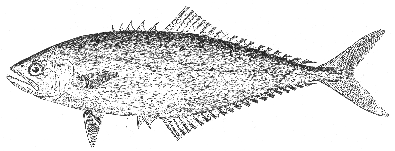Leatherjacket Oligoplites saurus (Bloch and Schneider) 1801
[Jordan and Evermann, 1896-1900, p. 898.]

Figure 206.—Leatherjacket (Oligoplites saurus), Marthas Vineyard. From Jordan and Evermann. Drawing by H. L. Todd.
Description—
The most interesting character of the leather jacket, and one which places it at a glance, is that the rear part of its soft dorsal fin back from the 7th ray, and also its anal fin back from the 5th ray, is broken, as it were, into a series of 12 low nearly separate finlets, the ray in each of which is subdivided at the tip like the hairs of a little brush. We need only note further that its body is about 3½ times as long as it is deep, very strongly flattened sidewise, and thin, being only about one-third as thick as it is deep; its upper jaw bone reaches back about as far as the rear edge of the eye; its snout is moderately pointed; its caudal peduncle very slender, with a low, inconspicuous keel on either side. Its first dorsal fin is reduced to about 5 separate spines, each with small fin membrane and its second dorsal has about 20 rays; its soft anal fin, also of about 20 rays, is preceded by two stout and conspicuous spines, forming, together, a separate finlet. Its lateral line is nearly straight, and its [page 381] scales are very small, and imbedded in the skin, which is corrugated with a great number of short, fine, longitudinal ridges, giving it a leathery appearance, hence its common name.
Color—
Bluish above, silvery below, with yellow fins.
Size—
The largest are about 12 inches long.
General range—
Common on both coasts of tropical America; northward to New York and southern Massachusetts (Woods Hole), reaching the southwestern part of the Gulf of Maine as a stray.
Occurrence in the Gulf of Maine—
The only record of this southern fish within the Gulf is of one taken in a trap off the outer beach at Chatham, Cape Cod.